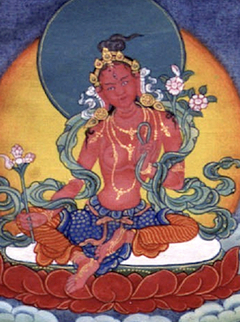Red Tārā Sādhana
༄༅། །སྒྲོལ་མ་དམར་མོའི་སྒྲུབ་ཐབས་ཁམས་གསུམ་མྱུར་འགུགས་ཞེས་བྱ་བ་བཞུགས་སོ།།
Swift Enchantment of the Three Realms
A Sādhana of Red Tārā
by Jamyang Khyentse Chökyi Lodrö
ན་མཿཏཱ་རཱ་བྷཊྚ་ར་ཀ་ཡ།
Namaḥ tārā-bhaṭṭarakāya!
སྒྲོལ་མ་དམར་མོའི་སྒྲུབ་ཐབས་ཁམས་གསུམ་མྱུར་འགུགས་ཀྱི་སྒྲུབ་ཐབས་ནི། རྗེས་གནང་ཐོབ་ཅིང་དམ་ཚིག་དང་སྡོམ་པ་ལྡན་པས་སྟན་བདེ་བ་ལ་འཁོད་དེ། མདུན་མཁར་སྐྱབས་ཡུལ་བསྒོམ་ལ།
For the means of accomplishing Red Tāra, the sādhana Swift Enchantment of the Three Realms, it is necessary to receive permission and uphold the vows and commitments. Sit on a comfortable seat, visualize the sources of refuge in the space in front, and recite:
བདག་སོགས་འགྲོ་ཀུན་བྱང་ཆུབ་བར། །
dak sok dro kün changchub bar
I and all other beings take refuge in the Three Jewels
དཀོན་མཆོག་གསུམ་ལ་སྐྱབས་སུ་མཆི། །
könchok sum la kyab su chi
From now until the attainment of awakening.
འགྲོ་ལ་ཕན་པ་བསྒྲུབ་པའི་ཕྱིར། །
dro la penpa drubpé chir
In order to bring benefit to beings,
སྒྲོལ་མ་དམར་མོ་བསྒོམ་པར་བགྱི།
drolma marmo gompar gyi
I shall meditate on Red Tārā.
ལན་ཅི་ནུས་དང་།
Repeat this as many times as possible. Then:
སེམས་ཅན་བདེ་ལྡན་སྡུག་བསྔལ་བྲལ། །
semchen deden dukngal dral
May sentient beings be happy, free from suffering,
བདེ་ཐོབ་བཏང་སྙོམས་ལ་གནས་ཤོག །
dé tob tangnyom la né shok
And having found happiness, abide in equanimity.
ཨོཾ་སྭཱ་བྷ་ཝས་སྦྱངས།
Purify with oṃ svabhāva… etc.
སྟོང་པའི་ངང་ལས་བྃ་ཡིག་དང་། །
tongpé ngang lé bam yik dang
Out of emptiness appears a syllable Vaṃ,
པདྨ་དམར་པོའི་ཟེའུ་འབྲུའི་སྟེང་། །
pema marpö zé'u drü teng
And upon the bed of a red lotus,
ཨཱཿལས་ཟླ་བའི་གདན་སྟེང་དུ། །
ah lé dawé den tengdu
From āḥ, upon a moon disc seat,
ཨུཏྤལ་དམར་པོ་ཧྲཱིཿདམར་མཚན། །
utpal marpo hrih mar tsen
Appears a red utpala marked with a red hrīḥ.
འོད་འཕྲོས་འཕགས་མཆོད་སྡིག་སྒྲིབ་སྦྱངས། །
ö trö pak chö dikdrib jang
Light radiates out, makes offerings to the noble ones, purifies wrongdoing and obscurations,
ཚུར་འདུས་རང་ཉིད་སྒྲོལ་མ་དམར། །
tsur dü rangnyi drolma mar
And as it returns I become Red Tārā,
ཞལ་གཅིག་ཕྱག་གཉིས་སྤྱན་གསུམ་མ། །
zhal chik chak nyi chen sum ma
With a single face, two hands and three eyes.
ཕྱག་གཡས་ལྕགས་ཀྱུ་གཡོན་ཞགས་པ། །
chak yé chakkyu yön zhakpa
She holds a hook in her right hand and lasso in her left,
བཅུ་དྲུག་ལོན་པའི་ན་ཚོད་ཅན། །
chudruk lönpé natsö chen
And has the youth of a sixteen year-old girl.
དར་དང་རིན་ཆེན་རྒྱན་གྱིས་བརྒྱན། །
dar dang rinchen gyen gyi gyen
She is adorned with silk and jewel ornaments
སེམས་དཔའི་སྐྱིལ་མོ་ཀྲུང་གིས་བཞུགས། །
sempé kyilmo trung gi zhuk
And sits in the cross-legged posture of a bodhisattva.
གནས་གསུམ་ཨོཾ་ཨཱཿཧཱུྃ་རྣམས་དང་། །
né sum om ah hung nam dang
At her three centres are the syllables oṃ āḥ hūṃ
ཐུགས་ཀར་ཧྲཱིཿཡིག་དམར་པོ་ལས། །
tukkar hrih yik marpo lé
And at her heart is red syllable hrīḥ,
འོད་འཕྲོས་ཡེ་ཤེས་པ་སྤྱན་དྲངས། །
ö trö yeshepa chendrang
From which light radiates out to invite the wisdom beings,
ཛཿཧཱུྃ་བྃ་ཧོ་དབྱེར་མེད་ཐིམ། །
dza hung bam ho yermé tim
Who merge indivisibly through jaḥ, hūṃ, baṃ and ho.
འོད་འཕྲོས་དབང་ལྷ་མདུན་མཁར་བཞུགས། །
ö trö wanglha dün khar zhuk
Light radiates and the empowerment deities remain before me in the sky.
དབང་བསྐུར་སྒྲིབ་དག་རིགས་ཀྱི་བདག །
wangkur drib dak rik kyi dak
They confer empowerment and purify obscurations.
འོད་དཔག་མེད་པས་དབུར་བརྒྱན་གྱུར། །
öpakmé pé ur gyen gyur
Amitābha, lord of the family, adorns my crown.
ལྷ་ཡི་གསལ་སྣང་ལ་སེམས་གཅིག་ཏུ་བཟུང་།
Focus single-pointedly on the clear appearance of the deity.
དེས་སྐྱོ་ན་བཟླས་པ་བྱ་བ་ནི།
When you grow tired, continue with the recitation:
ཐུགས་ཀར་ཨུཏྤལ་དམར་པོའི་སྟེང་། །
tukkar utpal marpö teng
At her heart, upon a red utpala,
ཟླ་བ་ལ་གནས་ཧྲཱིཿདམར་མཐར། །
dawa la né hrih mar tar
Is a moon disc and a red hrīḥ,
སྔགས་ཕྲེང་ཁ་དོག་དམར་པོས་བསྐོར། །
ngak treng khadok marpö kor
Surrounded by the mantra garland, red in colour.
འོད་འཕྲོས་རྒྱལ་བ་སྲས་བཅས་ཀྱི། །
ö trö gyalwa sé ché kyi
It radiates light, which attracts
བྱིན་རླབས་ཐམས་ཅད་དབང་དུ་བྱས། །
jinlab tamché wang du jé
All the blessings of the victorious ones and their heirs.
ཁམས་གསུམ་སྐྱེ་འགྲོ་ཐམས་ཅད་དང་། །
kham sum kyendro tamché dang
All living beings throughout the three realms
གང་འདོད་དཔལ་འབྱོར་འོད་དམར་གྱི། །
gang dö paljor ö mar gyi
And whatever magnificent riches I desire
རྣམ་པར་བསྡུས་ནས་སྔགས་ཕྲེང་ལ། །
nampar dü né ngak treng la
Are drawn towards me in the form of red light
ཐིམ་པས་དབང་དུ་བྱས་པར་བསམ། །
timpé wang du jepar gyur
And, being absorbed, brought under my control.
ཨོཾ་ཏཱ་རེ་ཏུཏྟཱ་རེ་ཏུ་རེ་སཾ་ཏཱ་རེ་ཏཱ་ར་ཎི་ཧྲཱིཿསྭཱ་ཧཱ།
om taré tuttaré turé sam taré tara ni hrih soha
oṃ tāre tuttāre ture saṃtāre tāraṇi hrīḥ svāhā
ཅི་རིགས་བཟླ། ཐུན་བསྡུ་ཁར་ཡེ་ཤེས་བ་མདུན་གྱི་ནམ་མཁར་བཞུགས་པ་ལ་དམིགས་ཏེ།
Recite this as many times as possible. At the point of concluding the session focus on the wisdom being in the sky before you and recite:
ཨོཾ་ཨཱརྱ་ཏཱ་རེ་ས་པཱ་རི་ཝ་ར་ཨོཾ་བཛྲ་པཱུཥྤེ་ཨཱཿཧཱུྃ།
om arya taré sapariwara om benza pupé ah hung
oṃ ārya tāre sapārivara oṃ vajra puṣpe āḥ hūṃ
སོགས་ནས།
Until:
ཤབྡ་བར་གྱིས་མཆོད།
shabda
Śabda
ལྷ་དང་ལྷ་མིན་ཅོད་པན་སོགས་ཀྱིས་བསྟོད།
Offer praise with “The devas and all other beings bow down and touch their crowns at your lotus feet...”1
ལྷ་དང་ལྷ་མིན་ཅོད་པན་གྱིས། །
lha dang lhamin chöpen gyi
O Tārā, the devas and all other beings alike
ཞབས་ཀྱི་པདྨོ་ལ་བཏུད་དེ། །
zhab kyi pemo la tü dé
Bow down and touch their crowns at your lotus feet;
ཕོངས་པ་ཀུན་ལས་སྒྲོལ་མཛད་མ། །
pongpa kün lé drol dzé ma
Mother of all buddhas, who liberates from every distress,
སྒྲོལ་མ་ཡུམ་ལ་ཕྱག་འཚལ་བསྟོད། །
drolma yum la chaktsal tö
I offer you homage and praise!
Then recite:
སྒྲོལ་མས་བདག་སོགས་སེམས་ཅན་གྱི། །
drolmé dak sok semchen gyi
Tārā, for me and all sentient beings,
སྣང་སེམས་དབང་དུ་སྡུད་པར་མཛོད། །
nang sem wang du düpar dzö
Bring appearances and mind under our control.
ཡེ་ཤེས་པ་རྣམས་དབྱིངས་སུ་གཤེགས། །
yeshepa nam ying su shek
Let the wisdom deities depart for basic space.
རང་གི་གནས་གསུམ་ཨོཾ་ཨཱཿཧཱུྃ། །
rang gi né sum om ah hung
My three centres are marked by oṃ, āḥ and hūṃ—
དཀར་དམར་མཐིང་གས་མཚན་པར་གྱུར། །
kar mar ting gé tsenpar gyur
White, red, and blue in colour.
ཅེས་བརྗོད་དགེ་བ་བསྔོ། །
Recite this and then dedicate the virtue.
ཅེས་པའང་བསྟན་པའི་སྦྱིན་བདག་ཆེན་པོ་ལ་དཀར་སྲས་མོ་རིགས་ལྡན་མ་དབང་མོ་དང་། སྒྲོན་མ་ཟུང་ནས་འདི་འདྲ་ཞིག་དགོས་ཞེས་གསུང་བསྐུལ་ངོར། ཆོས་ཀྱི་བློ་གྲོས་པས་བླ་མ་གོང་མའི་གསུང་ལས་བཏུས་ནས་སྦྱར་བའོ། །བྷ་ཝ་ཏུ། དགེའོ། དགེའོ། དགེའོ།། །།
In response to a request from Wangmo and Drönma, noble daughters of the Lakar family of great benefactors of the teachings,2 who expressed a need for just such a text, Chökyi Lodrö compiled this from the speech of past masters. Bhavatu. Virtue! Virtue! Virtue!
| Translated by Adam Pearcey with the generous support of the Khyentse Foundation and Tertön Sogyal Trust, 2020.
Source:
’Jam dbyangs chos kyi blo gros. "sgrol ma dmar mo'i sgrub thabs khams gsum myur 'gugs/" in ’Jam dbyangs chos kyi blo gros kyi gsung ’bum. 12 vols. Bir: Khyentse Labrang, 2012. W1KG12986 Vol. 7: 279–280
Version: 2.0-20250324
